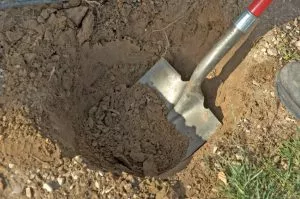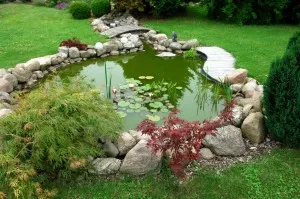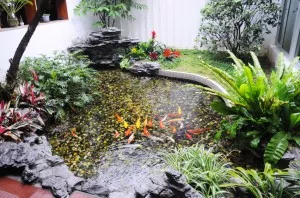With typical characterizations of fish and water lilies, pond features are becoming increasingly popular, and an affordable addition to your landscape.
MATERIALS: POND LINERS
There are two main types of pool liners most used today: rigid and flexible. Rigid liners are designs in which the contours of your pool are already mapped out. Flexible liners are typically used for larger pond projects, and need special surface preparation when being used (i.e. making sure the site is level and free from stones and debris. Flexible liners include three sub-types.
- Polyethylene: short lifespan (2-3 years), sensitive to long periods of sunlight.
- Polyvinyl chloride (PVC): last from 10-15 years, strong and stretchable.
- Synthetic rubber sheeting: life expectancy exceeds well past 20 years, two types available, durable, flexible, aquatic life safe, unaffected by sunlight and frost.
READY, SET, INSTALL
- Prepare the site location where the pond will be housed. This includes outlining the pond dimensions, sizing the liner accordingly, and digging the pond to your choice of depth. Remember however, if the pond is to welcome fish, there should be ample room for them to grow, swim, and stay warm.
- Hold the liner in place with concrete blocks, and smooth out the surface of wrinkles and air pockets.
- Install the pond pump, and filtration system, ensuring that all electrical outlets and wiring are up to safety codes.
ADDING AQUATIC LIFE TO YOUR FEATURE
Plants
In general, designers suggest covering the pond with one thirds plant life, including:
- Oxygenators: aptly named as their title suggests they contribute to increasing oxygen in the water.
- Floaters
- Floating-leaf: the plant’s leaves and flower float on the surface of the water (i.e. water lily).
- Shallow water or bog: situated on the upper pond ‘shelf’, in which the plant roots are submerged in water-soaked soil.
- Marginal aquatic: flourish in soil that is constantly damp.
These plants are best planted between the months of May and September in plastic or pulp planters. If adding fish to your pond, sprinkle gravel on the topsoil to ensure the earth will remain undisturbed by fish.
When winterizing plants, remove them from their planter, rinse and trim the end roots. You can keep the bulbs moist in a jar of distilled water, and place them in optimal sunlight view until ready to be repotted for the outdoor season.
Fish
The two types of fish most found in water ponds are goldfish and koi. Both differ in their pond needs as their sizes vary greatly, though it is suggested to wait until the pond’s ecosystem is well established (usually after a year), before adding them.
- Goldfish: can grow up to 16 inches, are able to live in as little water as 18-24 inches, and can happily swim along for 12 years.
- Koi: can grow up to 3 feet, and can live well beyond 50 years. Due to their size, they need greater and deeper (between 4-7 feet) water space. Koi can withstand winter months—provided freezing conditions is not an issue. Ponds that are deeper in depth allow for warmer temperatures and safer conditions for your fish. It is also critical for the fish to maintain a healthy ecosystem. Remember to de-ice a section of your pond so that oxygen can get in, and toxic gases can escape.
FINAL THOUGHTS: POND MAINTENANCE
Whether up-keeping or creating your first garden pond, its aesthetic appeal and health depend on your ability to identify problems, and commit to scheduled maintenance routines in order to ensure its continued flourishing success.
We carry all the supplies you’ll need to help your pond look as natural as possible. Call us to request a quote today!





